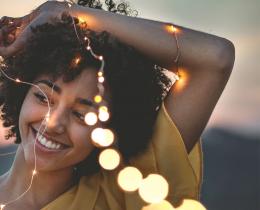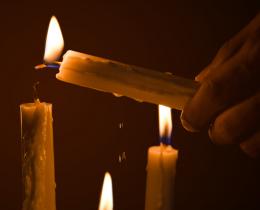Omega: How do you define bias? Do we all have it?
Rhonda: Bias is simply the tendency to have preferences, preconceptions, or prejudices. It's something that operates in degrees, but it's a tendency we all have to be drawn toward, or have some aversion toward, different things in life.
All of us, in some way or another, have set ways of thinking about ourselves and others. We have certain ways of thinking about those who are more like us or less like us. It's very common that we have bias. Social science has now shown that our brains are trained to identify categories of individuals that have relevance in our world.
Omega: How does this tendency become a problem for society?
Rhonda: The problem of bias as a social justice issue arises when bias attaches to social identities in groups. It's part of what we might call a process or dynamic of "othering"—of creating an "us versus them." Because social identities—race, gender, sexual orientation, class, religion, etc.—have had such an important meaning culturally, politically, and socially in America, we have inevitably been trained in how to navigate those systems.
Even if we don't believe we've been consciously indoctrinated to think about the world through the lens of bias, the science shows we have. We navigate through lenses of preconception that attach different types of meanings to different types of bodies, different places, and so on. Bias is a part of life.
Omega: What can we do to learn about our own biases?
Rhonda: There are implicit bias tests that institutions like Harvard and others offer online that can start to give you an idea of your own biases, based on whatever they’re measuring. Once you’re aware you can start to ask what you can personally do and what you can do with others to minimize your tendency to act on your biases.
The fact that we all have bias sometimes leads people to make the leap to the idea that there's nothing we can do about them, but this isn't true. Social psychology and cognitive science have revealed a lot about bias in recent decades and the research says this is just what it means to be a human in the 21st century. Once people hear about this research, in my experience most people begin to be receptive to the idea they have biases. It's not a question of moral failing, it's just how our minds work. Simply knowing how bias works is shown to start to interrupt our behavior. The early research also indicates that a course of short periods of mindfulness daily can also reduce our tendency to be biased.
Omega: Can you talk about the difference between color blindness and what you call color insight?
Rhonda: For a long time we tried to measure our progress in eliminating bias by asking how colorblind we were, how much we weren’t noticing race. Social psychologists like Claude Steele have helped us understand that it’s not possible to be colorblind, that the mind stereotypes. So despite our efforts to be colorblind, something else is going on.
Here I borrow from two scholars of race and law, Stephanie Wildman and Margalynne Armstrong, who argue for moving from the idea of color blindness to what they call color insight. We can learn to work more effectively with our own biases, stereotypes, and microaggressions, which we know we are operating with, with more insight. For example, do we make eye contact with certain people but have no eye contact with others?
I use the phrase "color insight practices" to describe a set of practices I've been working to develop and experiment with that have been specifically curated with a view toward deepening this kind of understanding. These include not just mindfulness and compassion, and mindful communication, but also specific practices around telling our stories and recognizing the way we hold certain wounds about ways we have suffered around our identities and felt hurt.
Omega: How does storytelling work to make us more aware of our biases?
Rhonda: All of us have stories around being wounded in one way or another. All of us have a story of trying to talk to someone about these issues and being misunderstood or worse, and we carry that with us. When we spend time talking with each other about our experiences and working on projects of mutual benefit and commitment, we can diminish bias—it’s called contact theory. It’s what led in many ways to the desegregation movements from a generation ago, which largely accounts for my being here with you today.
There are many things that get in the way of us being able to have contact with each other. If we haven't spent much time around people who have different backgrounds, it's normal and predictable that we’ll have discomfort around those who are different and a tendency to remain distant from each other. Storytelling is one of the ways I've been working to support the development of insight.
Omega: What kind of stories do you ask people to explore?
Rhonda: We each carry in ourselves a story of how bias works, and there is great value in inviting everybody into deep personal reflection on their life, on how they got to be where they are, and on their lineage and ancestors.
I have my law students look at the immigration histories of their families and right away we have a huge range of experiences. Native American students didn’t immigrate from anywhere but may have been dislocated. Some students have a heritage like mine where ancestors were forcibly migrated into the United States by enslavement. However we got here, what did our families go through? What kinds of neighborhoods and communities shaped us? It’s a rehumanizing process of locating ourselves in the larger narrative of humanity.
When we hear each other’s histories we realize we don’t know everything, which is why we need each other. Whatever our story, it’s only part of the big story of what it means to be human together.
Omega: What is your family story?
Rhonda: I was born in 1967 in a little town in North Carolina called Kingston. It was an explicitly segregated town when I was born, so I grew up deeply embedded in a community shaped by enslavement and all of the social and legal structures around that. Though slavery had ended some time before, the restrictions around who we could love, where we could live, what kinds of jobs we could have were still embedded in the community.
My grandfather was a sharecropper and my grandmother cleaned houses for people. These were jobs that enslaved people in a slave society would have held. So while there had been certain kinds of changes, the structures were still very much in place. Because of the Civil Rights Movement that brought about desegregation and affirmative action, little girls like me growing up in the American South had a chance at a different path. But I’m a combination of all that came before and I wouldn’t be here at all if it were not for the work I’ve done to reflect on who I am, where my family story intersects with the larger national story about race and gender, and where my personal story intersects with all of that.
My story has also left me with certain blind spots. As an African-American woman growing up in the South, I didn't have to worry about people mistaking me for an undocumented person. Similarly, as a heterosexual woman who has been married, I can look at how my life might have been different if I weren’t just Black and female but also lesbian or queer or intersex or trans. So there are so many ways I can look at my life and see how the particularities of my experience both inform and create natural connections on one hand but also create blind spots on the other. This has been really important work for me to do as I support others in deepening their own insight.



